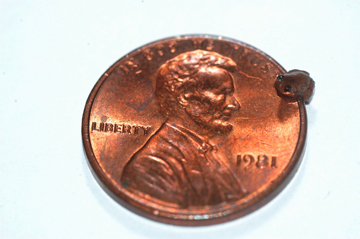As promised, I have been researching the species that I posted about yesterday morning. Today I found some more information on the Miniature Frog (Microhyla nepenthicola) which was discovered in Borneo in August of this year. The article I found can be found here.
This species of frog was found inside a species of pitcher plant named Nepenthes ampullaria. These plants live in areas which have nutrient poor, acidic soils and this makes it difficult for them to take in the nutrients they need. They have solved this problem by developing cavities that trap insects and kill them with a liquid. The frog has taken advantage of these cavities. It deposits its eggs on the side of the pitcher so that when they hatch, the tadpoles can enter the liquid in the cavities and grow.
M. nepenthicola is part of an amphibian family called microhylid. The family consists of frogs that are under 15mm long and according to Conservation International (CI), this species of frog is the smallest that has been discovered in this family. Adult males measure from 10.6 to 12.8mm long. Their amazing size can be seen on the picture below which was taken by Indraneil Das/ Institute of Biodiversity and Environmental Conservation and shows the frog on the side of a penny. It was thought that their tiny size could be the reason why this species has not been discovered until now. However, specimens that are the same species as this frog have been found in museum collections that are over 100 years old. They were not recognised as a new species and it was thought that they were merely juvenile frogs from other microhylid species.
Scientists discovered the frogs by tracking their call. It has been discovered that individuals of M. nepenthicola start singing at dusk with harsh notes. They sing for a few minutes at a time with intervals of quietness. The singing starts when the males gather within and around the pitcher plants and peaks in the early hours of the evening.
This discovery is part of the campaign that the CI and IUCN’s Amphibians Specialist Group are running. The campaign aims to rediscover many species of amphibians that are considered “potentially extinct”. According to the IUCN, these “lost amphibians” may still be living in remote parts of the world. The conservation status of amphibians will likely be highlighted with this campaign. Numbers of amphibians are currently declining world-wide due to use of pesticides, habitat destruction and other man-made problems. At least one third of all amphibians are currently classed as “threatened”. If you are interested, the campaign can be followed here.


No comments:
Post a Comment